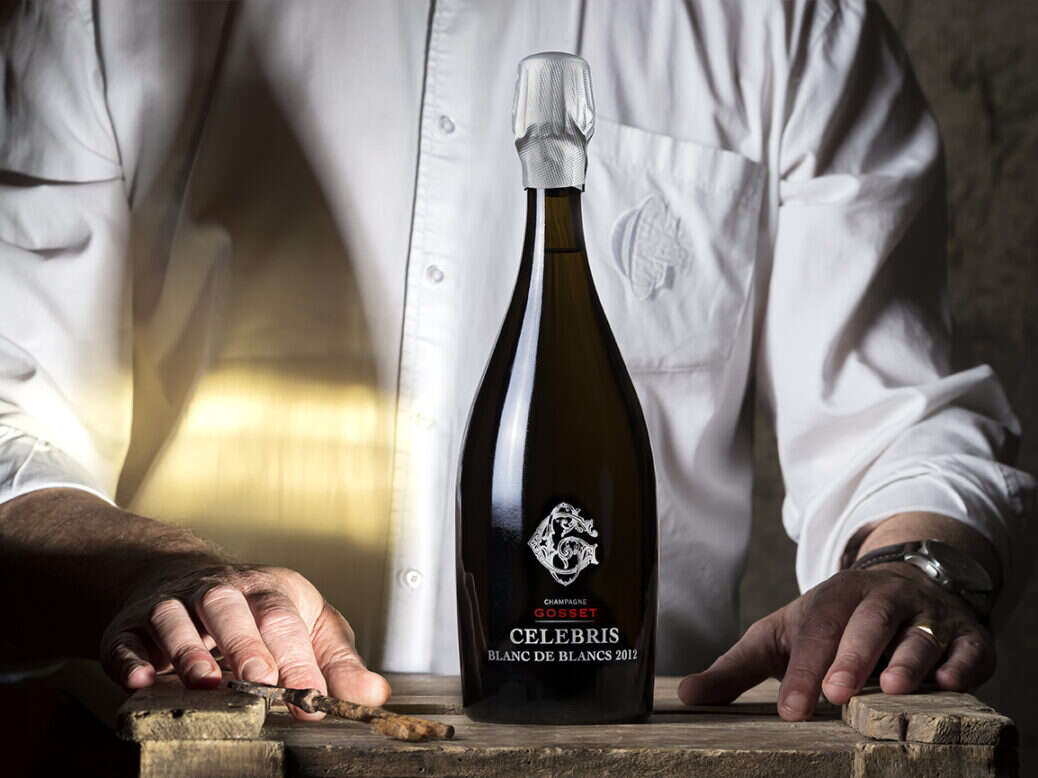
Champagne Gosset came late to Blanc de Blancs, but its newest release is exciting proof of its commitment to Chardonnay, says Simon Field MW.
Champagne Gosset chef de cave Odilon de Varine has been busy of late. On the back of 2008 Celebris Brut and Celebris Rosé and the latest manifestation of Grand Millésime, 2015, we now have a new cuvée in the Celebris Blanc de Blancs 2012, providing a sibling to the Blanc de Blancs NV and appearing to supersede the multi-vintage Blanc de Blancs that harnessed, for a one-off treat, the triptych of 1995, 1996, and 1998.
Odilon remembers, with a wry grin, that when he arrived at Gosset in 2006 he was “ashamed” that there was no blanc de blancs in the house repertoire. The intervening period has redressed the balance with no lack of enthusiasm. After having waited patiently since 1584, one has been rewarded with an embarrassment of Chardonnay.
Odilon warms to his theme. Forget the fact that Gosset is based in the northerly Champagne village of Aÿ and is therefore nominally (or so one might have thought) wedded to the darker grapes.
No, pace Odilon, Chardonnay is the key variety: “Chardonnay like this is what Champagne should be: salty and refreshing. We want roundness, and we want the softness of the chalk. The chalk comes from the sea, and the sea provides the salty freshness.”
One cannot gainsay such a peroration as his argument comes full circle. The two extant styles expertly capture the versatility of the variety; the NV, aged for three years, brings a “crisp and youthful tension,” and the far more mature Vintage expression (aged for nine years) engenders a “creamier style that evokes the powdery feeling of chalk.”
And what about another multi-vintage with only Chardonnay? Odilon does not rule this out. “Three vintages have to be complementary, as was the case with ’95, ’96, and ’98. I am sure that we will have such a situation again.” But the Vintage is to be a more permanent fixture.
Odilon then tags on two more of his hobby horses: lees-stirring (he approves, especially for Chardonnay, all in the name of texture) and lower pressure (5 bars rather than 6, for this gently elegant footprint). Bubbles and pressure coalesce into the thrust of his stylistic argument; the style sought must be gentle and seductive on the one hand, yet powerful and vinous on the other.
Bubbles are key, he jests: “This is Champagne, after all! The CO2 initially preserves against oxidation, but thereafter it is a wine enhancer, with bubbles creating the key link between the attack (vivacity and refreshment) and the back of the palate, which will juxtapose salinity and acidity and thereby ensure length.”
Most fundamentally, the fizz itself should never dominate, and the finish in particular should taper generously in the manner of, say, a Corton-Charlemagne, he decides, with recourse to a far from inconsequential Chardonnay by way of evidence.
2012 has been given the accolade of underwriting this new release, a vintage that I had, probably foolishly, previously considered to be more Pinot Noir-friendly. Not at all! It was, in fact, Chardonnay that rose to the very particular challenges of 2012 with the greatest aplomb: frost, hail, storms, mildew, drought… The horsemen of the meteorological apocalypse were paid overtime in the early days of this turbulent year but, for all their efforts, were unable to prevent a small, concentrated, powerful crop of grapes, Chardonnay excelling, it seems, on both sides of the valley.
Gosset: Champion of northerly Chardonnay
Gosset has, indeed, long championed the Chardonnays from the northerly villages, with Ambonnay, Cumières, Trépail, and Villers-Marmery just as significant here as the Côte des Blancs villages of Crémant, Vertus, and Le Mesnil-sur-Oger. The blend is made after a blind tasting across the villages, and there is nothing prescriptive in the sharing out of the crus.
Add to these the relatively little-known Marne Valley village of Passy-sur-Marne (“a great place for salty, expressive Chardonnay”), and the roll call is complete. Lees-stirring ensues, all in stainless steel, no malolactic fermentation, then a tirage of nine years. This one was disgorged in December 2021 and dosed at 7g/l—a little more than the other recent release, the 2015 Grand Millésime.
The wine was tasted at Marcus Wareing’s Michelin-starred restaurant at The Berkeley Hotel in London and, pleasingly, passed every step of the gastronomic challenge, breezing past the starter of chalk stream trout with cucumber, dill, and gin(!) and then, after drawing breath with the Celebris Rosé, Galloway beef and autumn truffle, redoubled efforts up against the not entirely straightforward combination of Gigha halibut, artichoke, onion, and anchovy, these last three words enough to strike great fear into all but the bravest of vignerons.
Fortune here favors the courageous Odilon. He has set out to create a powerful, resourceful, and supremely vinous Vintage Blanc de Blancs. He has brought it to market, and he has put it to the test. It has passed with flying colors on every level. Bravo! Be quick, though: there are only 15,000 bottles.
Gosset Celebris Blanc de Blancs 2012
Pale gold, shimmering with confidence; fine bubbles persist yet desist from intrusion. The aromatic recalls patisserie, frangipane, Braeburn apples, and a hint of grapefruit. The palate is marked by the geometry of excellence, length initially deferential to the breadth of pure fruit, itself garlanded by figs, tarte tatin, and a whisper of white chocolate, finally assuming control, the chalky salinity holding an ambitious panoply of gastronomic potential in check and underpinning a refreshing conclusion. | 94






